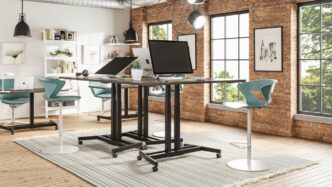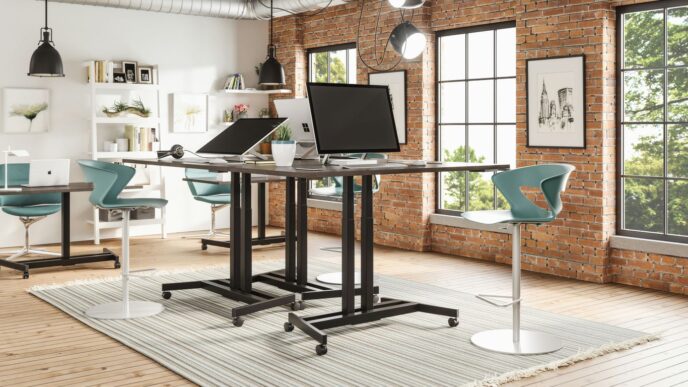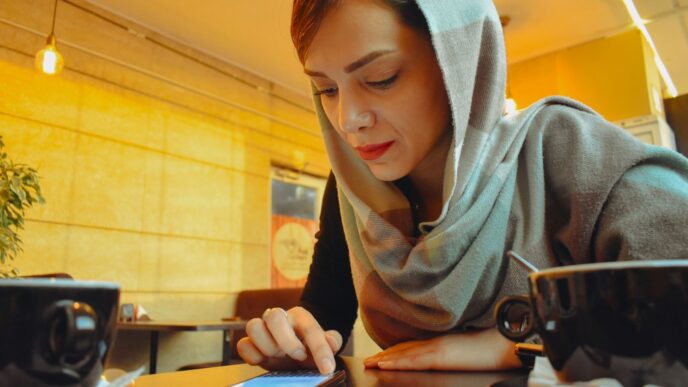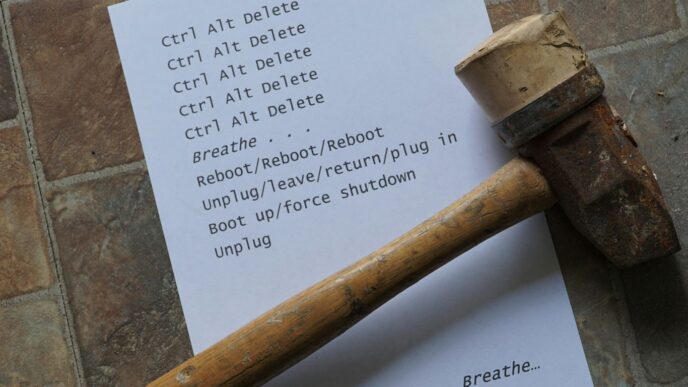Looking back at 2017, it’s clear that a lot of cool new technology inventions came out. Some of them were pretty wild, others just made everyday life a little bit easier. It was a year where robots started to feel more like friends, and where science fiction started to feel a little more real. From making homes safer to exploring Mars, these technology inventions 2017 really changed the game.
Key Takeaways
- Jibo, the personal robot, brought a new level of personality to human-machine interaction, making robots feel more relatable.
- Advancements in medical tech, like the eSight 3 for vision and new nanofiber sponges, showed big steps forward in healthcare.
- Space exploration got a boost with NASA’s Mars InSight Lander, and accessible VR became a reality with the Oculus Go.
- Smart home devices like Nest Secure and the Tasty One Top cooking companion aimed to make daily routines simpler and more convenient.
- The iPhone X pushed smartphone design forward, and the Tesla Model 3 accelerated the move towards electric vehicles, showing the impact of technology inventions 2017.
Revolutionizing Human-Machine Interaction
It feels like just yesterday we were talking to our computers with clunky keyboards and mice. Now, in 2017, things are getting a whole lot more personal, and frankly, a bit more human. We’re seeing technology that doesn’t just respond, but actually seems to interact with us on a different level.
Jibo: The Personal Robot With Personality
Remember those robots from sci-fi movies? Jibo is kind of like that, but he actually exists. He’s not just a speaker that lights up when you talk, like some other smart devices. Jibo has a face, and he uses little animated icons to show if he’s happy, curious, or maybe even a little confused. He can turn his head to look at you, dance a little jig, and even giggle. It’s a big step towards making machines feel less like tools and more like, well, companions. He can do basic things like tell you the news or snap a photo, but he’s still learning. At $899, he’s a bit of an investment, and he can’t do everything yet, like play music on command or connect with apps like Uber. But the folks behind Jibo are confident he’ll get smarter. It’s a fascinating glimpse into a future where our gadgets might actually feel more alive.
The Future of Conversational AI
Beyond just robots with faces, the way we talk to technology is changing dramatically. Think about how you interact with your phone or smart speaker now. It’s moving beyond simple commands. Artificial intelligence is getting much better at understanding what we mean, not just what we say. This means more natural conversations with our devices. Imagine asking your computer a complex question and getting a thoughtful answer, or having a virtual assistant that can actually follow a multi-step request without getting lost. This isn’t just about convenience; it’s about making technology more accessible to everyone, regardless of their technical skill. While we’re not quite at the point of having full-blown conversations with our gadgets like we would with a friend, the progress in 2017 shows we’re getting closer. The goal is to make interacting with technology feel as easy and intuitive as talking to another person.
Advancements in Medical Technology
2017 really brought some cool stuff to the medical world, making things better for patients and doctors alike. It wasn’t just about new drugs; we saw some genuinely clever inventions that tackled everyday problems in healthcare.
eSight 3: Restoring Vision for the Legally Blind
Imagine not being able to see clearly, and then suddenly, with a device, the world snaps into focus. That’s what the eSight 3 aimed to do. This wasn’t just a pair of glasses; it was a wearable electronic visual aid. It uses a camera to capture what’s in front of you and then displays it on two small screens, one for each eye. The cool part is that you can adjust the magnification, contrast, and color settings. This meant people with conditions like macular degeneration, glaucoma, or diabetic retinopathy could actually see faces, read books, and do things they thought were impossible before. It’s a pretty big deal for regaining independence.
Precision Syringe for Enhanced Medical Procedures
Sometimes, the simplest-looking tools can make the biggest difference. The Precision Syringe, developed at the University of Nebraska Medical Center, was one of those things. It’s designed to give much more accurate doses of medication, especially for things like chemotherapy or when dealing with very small amounts of liquid. Getting the dose exactly right is super important in medicine, and this syringe helps reduce errors. It’s a good example of how improving a basic medical instrument can have a significant impact on patient safety and treatment effectiveness.
The Promise of Nanofiber Sponges in Healthcare
This one sounds a bit sci-fi, but it’s real. Researchers developed a new type of sponge made from nanofibers. These aren’t your typical kitchen sponges, obviously. In healthcare, they have a lot of potential. Think about wound care: these sponges could be designed to absorb fluids, deliver medication directly to a wound, or even help tissue regenerate. They can be made very precisely, meaning scientists can control how they work. The idea is to create materials that can actively help the body heal or fight off infections. It’s early days, but the possibilities for treating injuries and diseases are pretty exciting.
Innovations in Space Exploration and VR

This year, we saw some pretty cool steps forward in how we explore the cosmos and how we experience virtual worlds. It feels like science fiction is slowly becoming reality, which is pretty wild to think about.
NASA’s Mars InSight Lander: Probing the Red Planet’s Interior
Getting to Mars isn’t exactly a quick trip; the planets only line up for the fastest journey every couple of years. NASA was ready for the 2018 window, planning to launch the InSight lander. The whole point of InSight, which stands for Interior Exploration using Seismic Investigations, Geodesy and Heat Transport, was to take a really close look at what’s going on inside Mars. Unlike those rovers that zip around, InSight was designed to stay put. It was going to hammer a probe deep into the Martian ground, over 16 feet, to basically take the planet’s geological temperature. Scientists were also using its seismometers to study Mars’ makeup and analyze how the planet wobbles on its axis. Cameras were set to send back pictures, too. The mission was expected to last for about two Earth years, just in time for the next Mars mission.
Oculus Go: Accessible Standalone Virtual Reality
Virtual reality has been around, but it’s often been a bit of a hassle. You usually need a separate computer or even your phone hooked up to the headset. Facebook’s Oculus Go changed that a bit. It was basically a self-contained VR device, meaning you didn’t need any extra gear. For $199, it was a much easier way for people to get into VR without a big setup. Now, it wasn’t going to give you the absolute most realistic experience out there – there are always trade-offs when you’re trying to make something light and affordable. But the big idea behind Oculus Go was to make VR more available to everyone. It was about removing some of the barriers so more people could just jump in and try it out without feeling like they had to buy a bunch of expensive stuff.
Smart Home and Personal Convenience
This year saw some pretty neat gadgets that aimed to make our lives at home a bit easier and more secure. It feels like every other day there’s a new device promising to simplify something, and 2017 was no exception.
Nest Secure: Simplified Home Security Systems
Remember when setting up home security felt like you needed a degree in engineering? Nest Secure tried to change all that. Instead of just focusing on keeping people out, they put a lot of thought into making it simple for you to get in and manage things. You could wave a key fob to disarm it, which felt way less clunky than punching in codes, especially when your hands are full. Plus, you could set specific times for fobs to work – handy if you had a babysitter or a dog walker. The smartphone app was a nice touch too, letting you check in on your home from pretty much anywhere. It wasn’t the only system trying this, but Nest’s approach felt pretty user-friendly.
Tasty One Top: The Connected Cooking Companion
BuzzFeed’s Tasty videos are everywhere, right? They make cooking look so approachable. But there’s a big jump from watching a video to actually doing it in your own kitchen. The Tasty One Top is basically an induction cooktop that talks to the Tasty app on your phone. It guides you through recipes step-by-step, and a built-in sensor and thermometer keep track of things like steak temperature. So, no more guessing if your steak is medium-rare! It takes some of the guesswork out of cooking, which is great for anyone who gets a little nervous in the kitchen. It’s all about making cooking less intimidating and more predictable. They had a huge library of recipes ready to go, which is a big plus.
The Evolving Smartphone Landscape

It feels like just yesterday we were all amazed by smartphones that could do more than just make calls. Then, 2017 rolled around, and things really started to shift. We saw phones that looked and acted differently, pushing the boundaries of what we thought a pocket-sized computer could do.
Apple iPhone X: Redefining Smartphone Design
The iPhone X was a big deal. Apple went all-in on a new look, getting rid of the classic home button that had been around forever. Instead, the screen basically took over the whole front of the phone, stretching from edge to edge. This made the phone feel more immersive, especially when you were watching videos or playing games. Unlocking your phone also got a futuristic upgrade with Face ID, which uses your face to get you in. It was a bold move, and honestly, a bit of a gamble, but it definitely made other phone makers rethink their own designs. It wasn’t just about looks, though; the tech packed inside was meant to handle new things like augmented reality.
Augmented Reality Integration in Mobile Devices
Speaking of augmented reality (AR), 2017 was a year where it started to feel less like science fiction and more like something we could actually use every day on our phones. AR lets digital stuff blend with the real world you see through your phone’s camera. Think about games where characters pop up in your living room or apps that let you see how furniture would look in your actual house before you buy it. This wasn’t just a gimmick; it showed how phones could become tools for interacting with the world in new ways. Developers started building more AR features into apps, and phones got better processors to handle these demanding tasks. It was clear that AR was going to be a big part of what smartphones could do going forward.
Sustainable Solutions for a Better Future
This year, we saw some really cool ideas pop up that aim to help our planet. It’s not just about recycling anymore; people are thinking bigger, trying to change how we eat and how we get around.
GreenWave 3D Ocean Farms: Cultivating Sustainable Seafood
Farming on land is getting tougher, and our oceans are getting emptier. Bren Smith, who used to be a fisherman, started GreenWave. They’re growing oysters, mussels, clams, and seaweed on ropes that hang in the ocean. It sounds a bit different, but it makes a lot of sense. These sea crops don’t need fertilizer, they’re packed with protein, and get this – they actually help fight climate change by soaking up carbon dioxide as they grow. GreenWave has helped set up farms along the coast and is looking to spread the idea even further. It’s a smart way to get food without messing up the environment.
Tesla Model 3: Driving the Electric Vehicle Revolution
Electric cars have often been either super expensive or couldn’t go very far on a single charge. The Tesla Model 3 changed that game. It’s one of the first electric cars that’s more affordable and can travel over 200 miles without needing to be plugged in. People really wanted these cars, so much so that Tesla had trouble making them fast enough. This push towards electric vehicles is a big deal for reducing pollution and our reliance on gas. It feels like electric cars are finally becoming a real option for a lot more people.
Here’s a quick look at how the Model 3 stacks up:
| Feature | Specification |
|---|---|
| Price | Starting around $35,000 |
| Range | Over 200 miles |
| Fuel Type | Electric Battery |
| Impact | Reduced Emissions |
Disruptive Technologies in Everyday Life
Sometimes, the most impactful tech isn’t some giant leap for science, but something that just makes our daily grind a little bit easier, or a lot more fun. 2017 saw a few of these kinds of inventions pop up, changing how we do things without us even realizing it.
First up, let’s talk about getting the perfect shot. The DJI Spark drone came out, and it was a game-changer for anyone who loves taking photos or videos. Forget those awkward selfie sticks; this little guy could hover, follow you, and take amazing aerial shots with just a wave of your hand. It made professional-looking footage accessible to pretty much anyone. It was like having a personal aerial photographer in your pocket.
Then there’s the Molekule air purifier. We all want cleaner air, right? This thing used a totally different approach, breaking down pollutants at a molecular level instead of just trapping them. It was a pretty big deal for people with allergies or just anyone who cares about the air they breathe indoors. It promised a new way to tackle indoor air quality.
And for new moms, the Willow Pump was a revelation. Traditional breast pumps were often loud, bulky, and tied you down. Willow created a quiet, wearable pump that fit right into a bra. This meant moms could pump discreetly, anywhere, anytime – whether they were at work or just playing with their older kids. It was all about giving mothers more freedom and flexibility. It’s amazing how technology can help with something so personal, and it’s great to see innovations that support women’s health.
These inventions might not have been as flashy as some others, but they quietly made a difference in how we live, work, and capture memories.
Looking Back: The Most Impactful Technology Inventions of 2017
So, that was 2017 in a nutshell, tech-wise. It feels like just yesterday we were all getting excited about new gadgets and gizmos. From robots that seemed almost human to glasses that could actually help people see, it was a pretty wild year for innovation. We saw smarter phones, safer helmets, and even ways to grow food underwater. It’s easy to forget just how much changed, but looking back, these inventions really did make a mark. It makes you wonder what 2018 will bring, doesn’t it?
Frequently Asked Questions
What was the main idea behind the 2017 technology inventions?
In 2017, many new gadgets and tools aimed to make our lives easier and more connected. Think about robots that could talk to you, glasses that helped people see better, and even ways to explore space or cook food more easily. It was all about making technology more helpful and accessible for everyone.
How did technology change how we interact with machines in 2017?
Some inventions, like the robot Jibo, were designed to feel more like a person. Instead of just being a speaker, Jibo could move, show emotions with its face, and talk to you. This made talking to machines feel more natural and less like just giving commands.
Were there any inventions in 2017 that helped people with disabilities?
Yes, absolutely! The eSight 3 glasses were created to help people who are legally blind. These special glasses could help them see the world around them much better, making everyday tasks easier and safer.
What kind of advancements happened in space exploration in 2017?
NASA launched the Mars InSight lander. Its mission was to dig deep into the surface of Mars to understand what the planet is like underneath. It was like giving Mars a check-up to learn about its history and how it works.
How did smartphones get better in 2017?
The iPhone X was a big deal because it changed how smartphones looked, with a screen that went all the way to the edges. It also got smarter with features like unlocking your phone just by looking at it, and it was built to work better with new things like augmented reality.
Did any inventions in 2017 focus on helping the environment?
Definitely. The Tesla Model 3 was a major step in making electric cars more common and affordable, which helps reduce pollution from gasoline cars. Also, GreenWave started creating underwater farms for seafood and plants, which is a more sustainable way to get food and helps the ocean.














